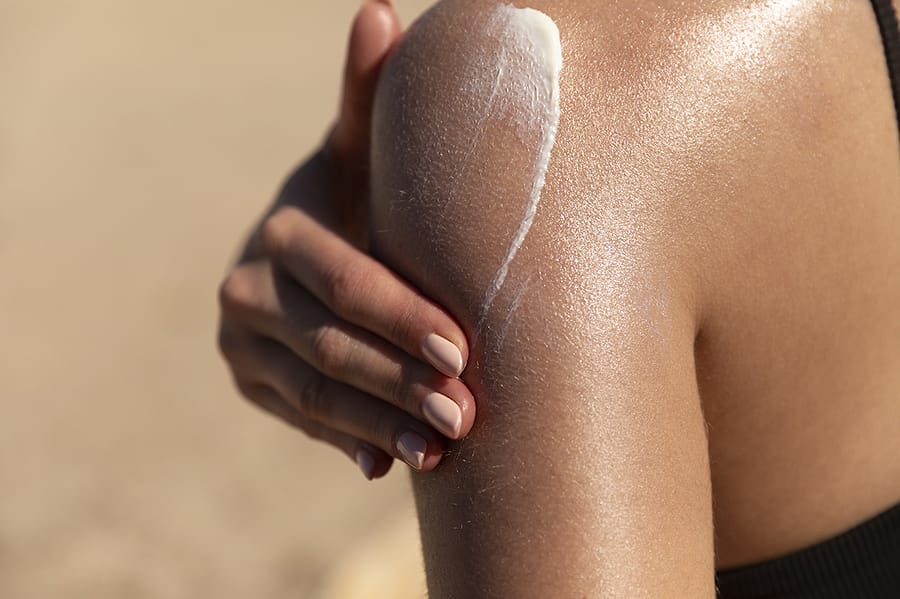If you’re among the 11% of Americans who use sunscreen every day, you’re already well ahead of the curve in preventing premature skin aging and lowering your risk of skin cancer. However, not all sunscreens are equal and each gives varying degrees of protection against the different types of UV radiation. Even more concerning, some sunscreens contain ingredients that are at the center of an ongoing debate about safety.
The FDA proposed an overhaul of the regulations for sunscreens in 2019 and determined that some sunscreen ingredients need to undergo more testing to determine their potential for long-term health consequences.
With more data on the safety of sunscreen ingredients coming out all the time, recent bans of some sunscreen ingredients in several states and the rate of melanoma soaring, it’s more important than ever to educate ourselves on what we are actually slathering on our skin in hopes that we’re protected.
In this series on sun protection, I’ll cover some of the recent studies the FDA ordered on specific sunscreen ingredients, strategies for preventing premature skin aging and cancers, how to become a pro at reading sunscreen labels, and how some sunscreen ingredients may be adversely impacting our health and environment.
In this article we’ll start with the basics: the two distinctly different types of sunscreens–mineral and chemical. We’ll look at how they work, and why it might be important to your health.
How Mineral Sunscreens Work
Mineral sunscreens contain naturally occurring minerals that work as UV filters in their formulas. These active ingredients act like tiny reflectors that sit on the surface of the skin and actually deflect UV radiation away from the body, before it can penetrate the skin.
Unlike the ingredients in chemical sunscreens, mineral filters are not absorbed into the bloodstream. Instead, they remain on the surface like a shield when applied to the skin. Because of this, mineral filters are currently the only ones considered as safe and effective by the FDA. They are also generally considered as generally safe for pregnant women and babies. In fact, the American Academy of Dermatology recommends using mineral sunscreens on babies because it’s less likely to cause irritation to their skin.

What Are the Ingredients in Mineral Sunscreens?
There are 16 UV filters approved by the FDA for use in sunscreens in the US. Only 2 of them are mineral filters—zinc oxide and titanium dioxide.
Zinc Oxide
Zinc oxide is a compound produced from naturally occurring zinc deposits. Historical references tell us it has been used in salves, medicines and topical lotions for hundreds of years. Older formulations containing zinc oxide were typically thick, white creams that were hard to rub into the skin. Modern formulas are made with smaller particles so they’re easier to apply and don’t leave a white cast.
Zinc oxide is photostable, meaning it doesn’t break down with exposure to sunlight. It gives broad spectrum protection against both UVA and UVB radiation. It doesn’t commonly cause commonly cause skin reactions and, in fact, many diaper rash creams contain zinc oxide to help soothe irritated skin.
Titanium Dioxide
Titanium dioxide is mineral commonly used in many commercial products including cosmetics, soaps and sunscreens. Its pure form is extracted from mined, naturally occurring titanium ore deposits.
Titanium dioxide also provides both UVA and UVB protection but somewhat less UVA protection than zinc dioxide does. The two work well together and are often paired in mineral formulas to give the broadest range of protection.
Potential Drawbacks of Mineral Sunscreens
Modern mineral sunscreens use nanoparticles of zinc oxide and titanium dioxide. This makes the formulas more effective and easier to blend into skin. However, spray-on formulas containing these tiny nanoparticles have the potential to cause harm to the lungs when inhaled. Because of this, spray formulas that use nanoparticles are not recommended.
Like any sunscreen, mineral formulas need to be reapplied throughout the day for maximum effectiveness—ideally every two hours.
How Chemical Sunscreens Work
Chemical sunscreens are formulas that use chemical compounds as UV filters. These chemicals work by penetrating the skin where they absorb UV radiation from the sun and, through a chemical reaction, convert it into heat. The heat from this chemical reaction is then dissipated through the skin. This reaction is why chemical UV filters can sometimes cause skin irritation and sensitivity.
The absorption of UV radiation also causes rapid breakdown of some of the chemical filters which aren’t photostable. Because of this, chemical formulas often contain additional chemicals to help stabilize the active ingredients and keep them from breaking down too quickly.
Some chemical formulas also contain specific compounds that help the active ingredients to better penetrate the skin. Regardless of the formula, chemical sunscreens should also be reapplied every two hours for them to be effective.

What Are the Concerns About Chemical Sunscreens?
Recent studies ordered by the FDA have shown that chemical UV filters enter the bloodstream at much higher levels than previously known—even after one application. Even more concerning is that these chemicals stay in the body, including in breastmilk, for up to weeks at a time and levels keep increasing with each reapplication.
Although absorption of the chemicals into the bloodstream in itself is not necessarily a danger to our health, the problem is that the commonly used chemical filters show evidence of hormone disruption in many animal studies. Evidence that these ingredients can potentially have long-term health consequences is mounting, making quality human studies necessary.
With all of the chemical UV filters under scrutiny and a lack of data confirming their safety for use in humans, The FDA placed them in a different safety category pending further studies to determine at what levels, if any, they should be allowed in sunscreens. At this time, none of the chemical filters are generally recognized as safe and effective (GRASE) by the FDA.
What Are the Ingredients in Chemical Sunscreens?
There are 6 commonly used chemical UV filters in the US. (The FDA maintains a list of 16 approved UV filters in total but some of them have fallen out of use due to ineffectiveness or have already been determined to be unsafe).
All 6 of these chemical filters were shown in studies to be absorbed into the bloodstream after 1 application:
Oxybenzone
Oxybenzone is a chemical filter that absorbs UVA and UVB rays. It’s been in the news lately because it was recently banned in Hawaii and Key West, Florida after studies implicated it in causing damage to coral reefs. It was also banned in the US Virgin Islands in 2020.
Oxybenzone is a known hormone disruptor (also called an endocrine disruptor) in animals, affecting estrogen production and androgen production. Some companies are proactively pulling oxybenzone from their products. CVS removed oxybenzone from all its formulations of less than 50 SPF in 2020.

Avobenzone
Avobenzone is the most commonly used chemical UV filter, absorbing both UVA and UVB rays. Because it breaks down within 30 minutes of being exposed to sunlight, it has to be paired with a chemical stabilizer. Studies on human cell lines have indicated that avobenzone may have endocrine disrupting effects.
Octinoxate
Octinoxate is a chemical filter that mainly absorbs UVB radiation. Like oxybenzone, it’s been banned in Hawaii, Key West Florida and the US Virgin Islands due to evidence that it damages coral reefs. Octinoxate is a suspected endocrine disruptor in humans and is absorbed easily through the skin. CVS has also removed octinoxate from most of its sunscreen formulas.
Octisalate
Octisalate is a chemical UVB filter. It’s used in formulas to help other ingredients stay on the skin longer when exposed to water. Because it only filters UVB rays, it has to be paired with other UVA filters like avobenzone or oxybenzone to provide adequate full-spectrum protection. Octisalate is also used to help the other active ingredients penetrate more easily into the skin.
Homosalate
Homosalate is a chemical UVB filter. It’s not photostable, meaning it must be paired with other chemical stabilizers. Like all other chemical UV filters on this list, homosalate has been shown in studies to enter the bloodstream and is a potential endocrine disruptor.
Octocrylene
Octocrylene is a chemical UVA and UVB filter. It’s often used as a stabilizer used to keep avobenzone from breaking down too quickly. A recent study indicates that formulas containing octocrylene may also contain harmful compounds called benzophenones since octocrylene can break down into benzophenone over time. Octocrylene has also been shown to damage coral reefs and is banned in the US Virgin Islands.
What About Mixed Formulas
Some sunscreen manufacturers use a combination of mineral and chemical filters their formulas. With these products, you get the benefit of mineral sunscreens with the easier application of chemical sunscreens. If you decide, based on current evidence and recommendations, to avoid chemical filters at this time, be aware that some formulas containing both types of mineral and chemical ingredients may be labeled as mineral or natural formulas. Carefully reading the label is the best way to know exactly what you’re getting.
Conclusion
Proponents of chemical sunscreens say there is no definitive proof that their ingredients are harmful to humans and this is true. So far the studies mainly show that the chemicals are absorbed into the bloodstream at higher levels than previously thought. Studies on animals show that most of the chemical UV filters are potential endocrine disruptors but this has yet to be confirmed in human studies.
So, what do we do as we wait for more data? We can be proactive and learn everything we can about the currently available evidence and follow the recommendations of the FDA and experts for a start.

And while not all experts agree on the relative safety of chemical sunscreens they do agree on one thing: that wearing any sunscreen is better than wearing none at all to prevent melanoma and other types of skin cancer and skin damage.



